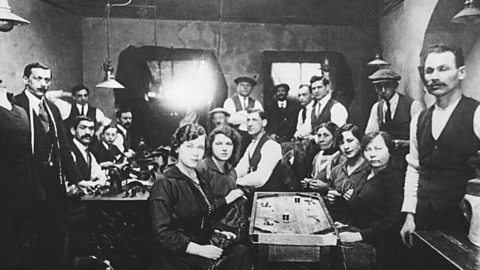Immigration
- The population of Whitechapel changed regularly because of the casual work available for migrants living by the docks, as well as temporary accommodation available in lodging houses.
- The changing population led to fears of crime and tensions within the community.
- For centuries Irish and Eastern EuropeanmigrantA person who moves from one country to another, often to find work., including Jewish people from Eastern Europe and the Russian Empire had settled in Whitechapel after their boats arrived at the East End docks.
- In Whitechapel, they were able to find jobs, cheap places to sleep and communities of similar people.

Irish migrants
Irish migrants had been settling in Whitechapel since the 1840s and by c.1870 there were well-established Irish lodging houses. It was mostly Irish workers who were employed at the docks as ‘navvies’ (navigators); doing labouring jobs on canals, railways and roads; or working as dockers on the Thames. They were characterised as being drunk and violent.
Jewish migrants
After 1881, Russian Jewish people started to come over to England in large numbers, in order to avoid persecutionTo ill-treat people for their religious or political beliefs. following the assassination of Tsar Alexander II. Between 1881 and 1891, 30,000 Russian migrants arrived in London. However, they found it hard to integrate because of differences in language (they spoke YiddishA language used by Jews in central and eastern Europe before the Holocaust. and differences in cultural factors such as religious holidays, food and clothing. They also observed SabbathThe seventh day of the week and a day of rest for Jews (Shabbat is Friday sunset to Saturday sunset). Sunday is the day of rest for Christians. rituals on a Saturday, when they were expected to work.
As a result, Jewish people tended to live in self-segregated communities, or ghettoA poor part of a city that is usually occupied by a minority group, sometimes purpose built. in East London. Many Jewish migrants started to work in sweatshopA place - workshop or factory - where people are forced to work long hours or in harsh conditions. making clothes and shoes for Jewish employers, where conditions of work were poor and wage levels were low. This caused great resentment from other traders, who could not fairly compete on price. The segregation of Jewish migrants from other communities caused them to be targets of prejudice and anti-SemiticHostile to or prejudiced against Jewish people. They were also distrusted by the Whitechapel police.
More information on Jewish life in Europe before World War Two can be found in this article - Jews in pre-war Europe.
Socialism and anarchism
Some people in Whitechapel were worried about political ideas such as a socialismA political system in which all property and wealth is owned by the whole community and not by individuals. and anarchismThe belief in the abolition of all government and movement towards organising society by voluntary or cooperative means. being brought over to London by migrants, especially from Eastern Europe.
- The idea of anarchism was developed by Russian revolutionaries.
- Some Jewish migrants brought the idea of socialism to London with them and set up socialist organisations such as the International Working Men’s Educational Club and a newspaper, Worker’s Friend, in Whitechapel.
- British politicians and the English media saw both the idea of anarchism and Jewish immigration as a threat.
When the third victim of Jack the Ripper, Annie Chapman, was found in the yard of the Berner Street theatre, where the Worker’s Friend was printed, the Whitechapel community blamed the murders on a Jewish man. Rumours circulated that a Russian anarchist, Nikolay Vasiliev, was responsible for the murders. However, it is unlikely that he ever existed.
There was never a connection found between the political anarchists and the murder of Annie Chapman, but the police were distrustful of the community because they were unable to speak Yiddish and so were not able to monitor the community.
Prejudice against migrants
Irish migrants were targets of prejudice because many of them were Catholics and there had been a rise in Irish nationalism and Irish republicanism that some people in Britain feared. At the end of the 19th century, Ireland was ruled by Britain. Some people wanted Ireland to remain part of the United Kingdom but an increasing number of people wanted home ruleThe demand by countries within the British Empire to be given the right to govern themselves independently but remain within the British Empire. and other people wanted complete independence for Ireland from Britain.
Fenians were mainly Catholic Irishmen who demanded Irish independent rule from Britain. After a bomb attack on Clerkenwell prison in 1867, the Metropolitan Police formed Special Branch - a police department dedicated to countering Irish terrorism. A further bomb was exploded at Gower Street Station in 1885. Much of the British media labelled Irish people in London as potential traitors.
These fears led reformers to want to knock down the rookeryA slum area in a town or a city where rates of poverty and crime were high. and lodging houses in migrant communities and replace them with new housing projects like the Peabody Estate. However, these housing projects did not provide accommodation for those most in need, and they led to further overcrowding in other lodging houses. The problem seemed impossible to solve, and efforts to improve the conditions in Whitechapel were not successful.
More guides on this topic
- Crime and punishment in Britain overview - Edexcel
- Crime and punishment in medieval England, c.1000-c.1500 - Edexcel
- Crime and punishment in early modern England, c.1500-c.1700 - Edexcel
- Crime and punishment in 18th- and 19th-century Britain - Edexcel
- Crime and punishment in modern Britain, c.1900 - Edexcel